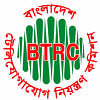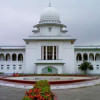BTRC to purchase equipment to measure mobile tower radiation

The telecom regulator has decided to purchase equipment for measuring the levels of radiation emanating from mobile phone towers as it seeks to bolster its capacity to carry out such activities nationwide.
As such, Bangladesh Telecommunication Regulatory Commission (BTRC) has already approved an open tender (international) to this end, according to an official document.
Initially, the projected budget for this is estimated at Tk 12 crore.
The equipment will measure the towers' electromagnetic field (EMF), a type of non-ionising electromagnetic radiation that does not have enough energy to damage DNA and cannot directly cause cancer.
The EMF carries wireless communication signals for connectivity.
The move follows a previous directive of the High Court requiring the BTRC to examine the possible harmful effects of the EMF on the human body and nature.
After that, the BTRC purchased two sets of EMF radiation measurement equipment in November.
But although the existing equipment sets are still effective and being used to conduct surveys, they are inadequate for examining all the towers across the country as per the HC's order, the document shows.
So, the commission will now purchase four sets of broadband EMF radiation measurement systems with the required number of shaped probes to cover a frequency range of 5MGz to 50GHz.
Additionally, the BTRC will procure two sets of broadband EMF area monitoring devices (basic unit) with necessary flat probes to cover a frequency range of 5MHz to 40GHz.
One central controlling system for the area monitoring system, with software, will also be purchased.
The harmful radiation emanating from mobile phone towers in Bangladesh is considerably lower than the safety levels set by international bodies, found BTRC surveys throughout last year.
Besides, there is no harm to the environment, said the surveys carried out in nine cities.
The regulator found that the radiation is 20 to 30 times lower than the international standard across 99 spots in Dhaka, Mymensingh, Jamalpur, Sylhet, Moulvibazar, Rangpur, Gaibandha, Khulna and Jashore.
For instance, 0.01453 milliwatts per square meter (mW/m²) was recorded when measurements were taken at the Khulna district administration office from August 22 to August 25.
The permissible threshold for exposure to EMF is 2.106 mW/m², according to guidelines set by the International Commission on Non-Ionising Radiation Protection, International Telecommunication Union and World Health Organization.
Therefore, the current level of radiation poses no threat to either public health or the environment, the BTRC said in its survey reports released at different times.
Cellular phones communicate with nearby cell towers mainly through radiofrequency waves, a form of energy in the electromagnetic spectrum between FM radio waves and microwaves, according to the American Cancer Society.
Like FM radio waves, microwaves, visible light and heat, they are forms of non-ionizing radiation.
This means they do not directly damage DNA, which is how stronger (ionizing) types of radiation such as x-rays, gamma rays, and ultraviolet rays are thought to be able to cause cancer, it said in its website.
One of the few known effects of radio waves on the human body is a very small rise in temperature of up to 0.2 degree Celsius. But research is continuing to make sure that there are no potential long-term effects.
Earlier, Satya Prasad Majumder, vice-chancellor of the Bangladesh University of Engineering and Technology, told The Daily Star that the degree of radiation a tower emits would not cause any problem.
"You can't read without light and similarly too much light would harm the eye. A minimum level of radiation is given off the antenna and is designed taking all safety concerns into account so that people can talk on phones without facing any problem from that," he said.
"People who are concerned about it don't know anything about it. They got panicked when the world introduced 1G or 2G and are still in panic but the world is poised to introduce 6G. If they were right, technology would not have advanced," Majumder added.
According to telecom industry people, baseless fears surrounding the health risks associated with radio waves emitted by phone masts have emerged as a significant obstacle to the advancement of superior telecom services, hindering the efforts of telecom and tower service providers.
For example, building owners, particularly in Dhaka and other metropolitan areas, are reluctant to lease out their rooftops to telecom service providers in fear of radiation.

 For all latest news, follow The Daily Star's Google News channel.
For all latest news, follow The Daily Star's Google News channel. 








Comments